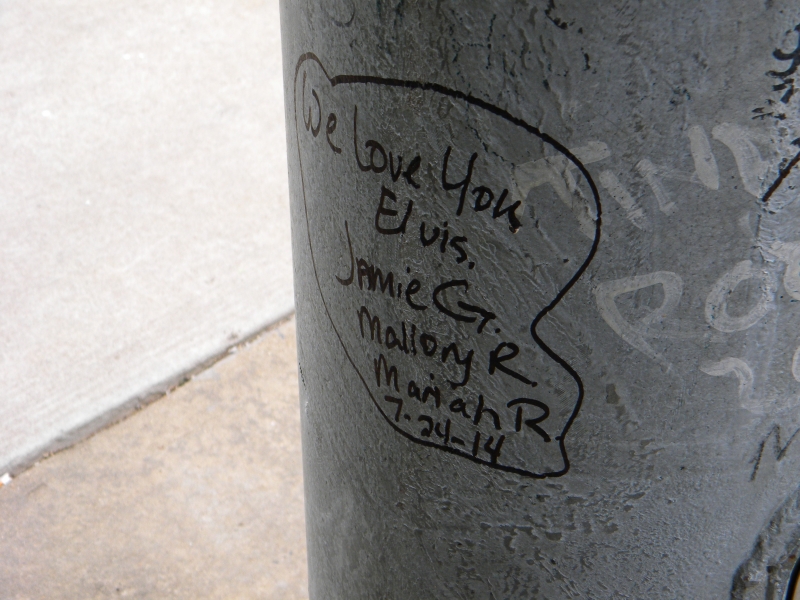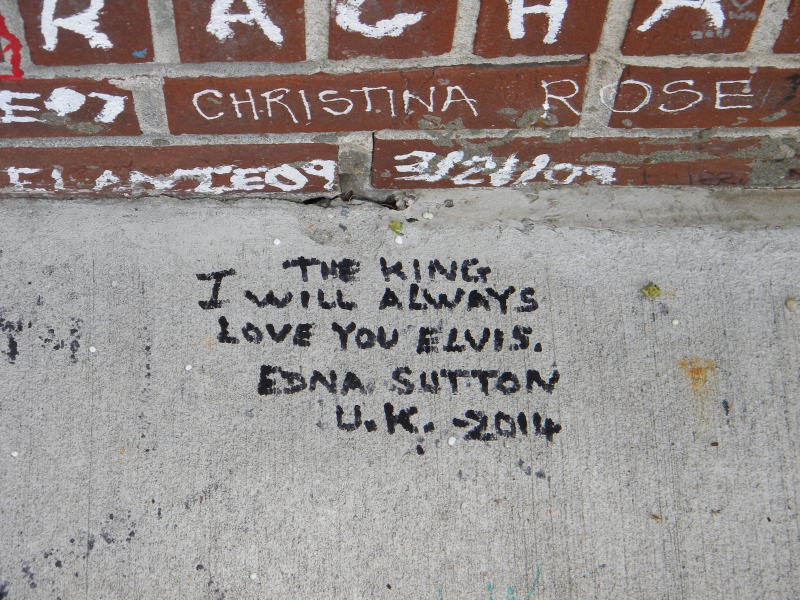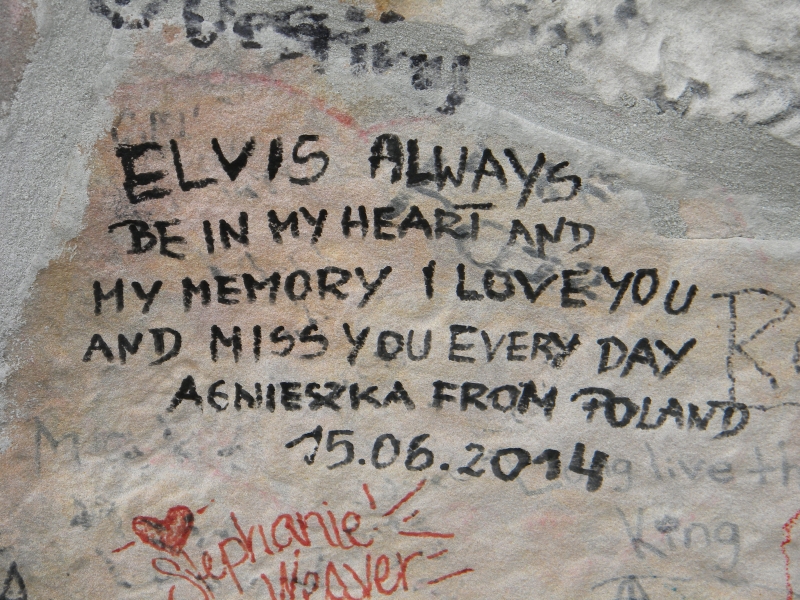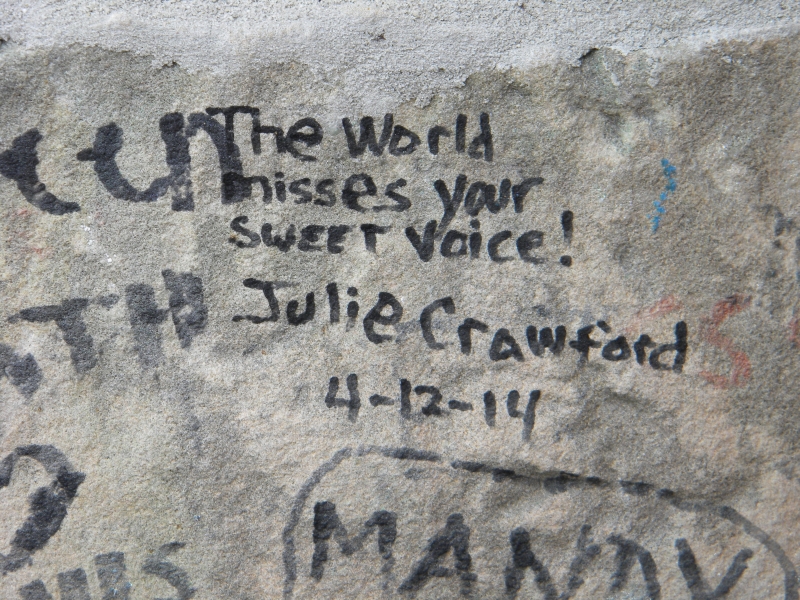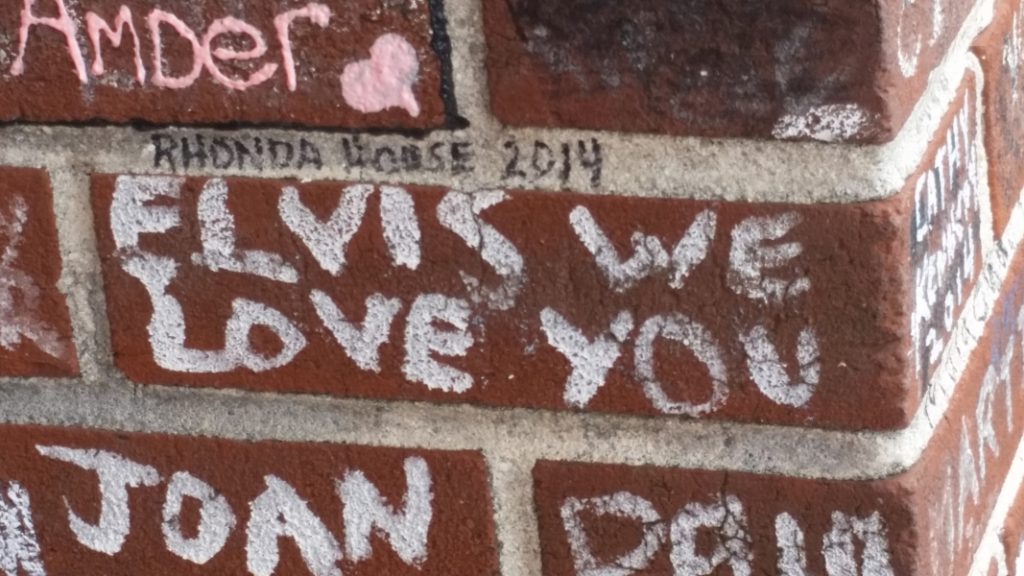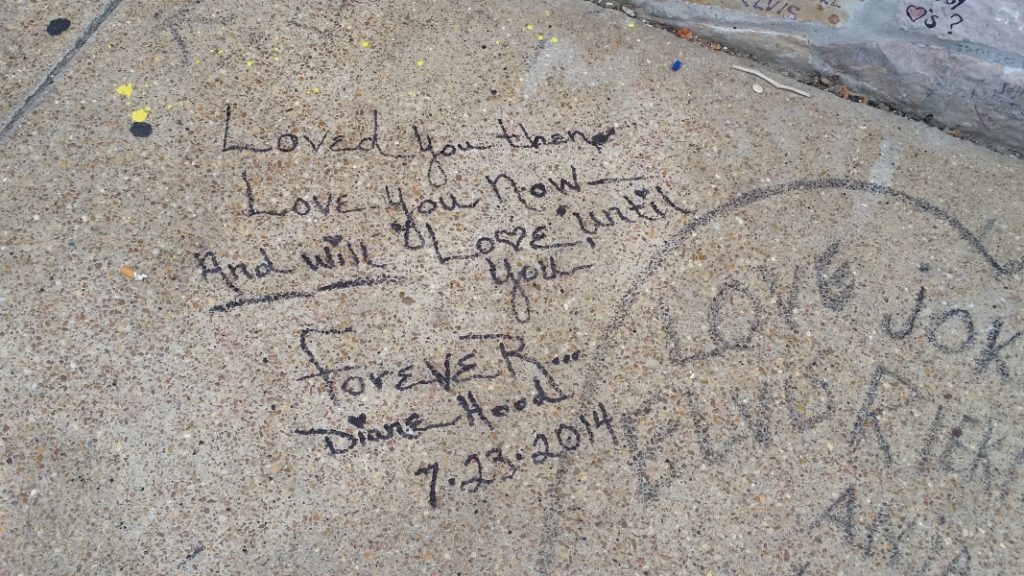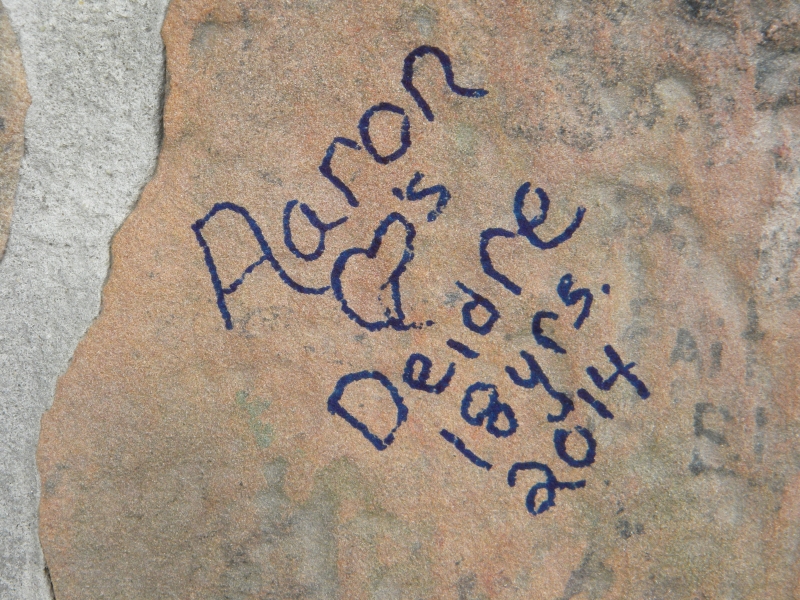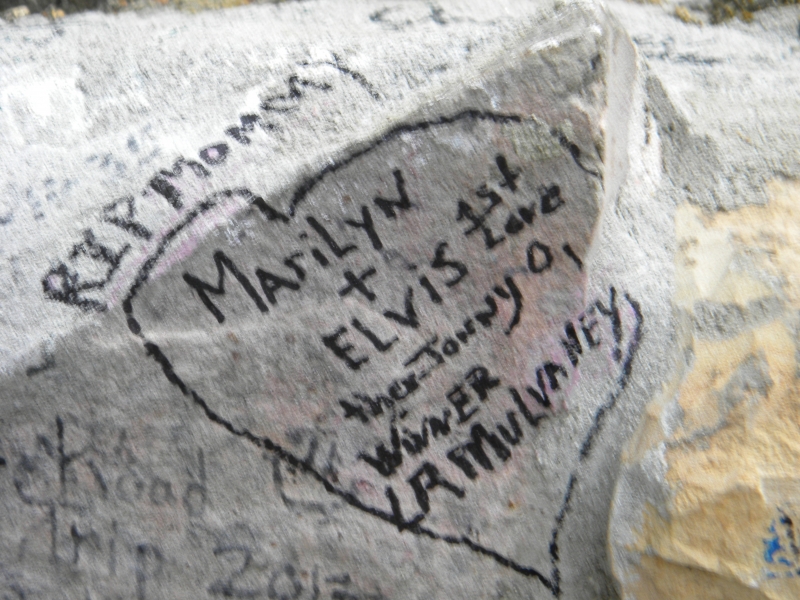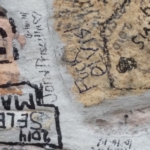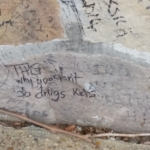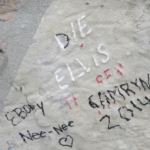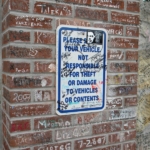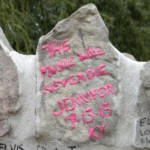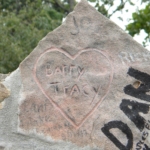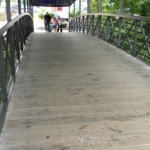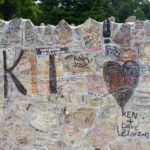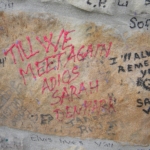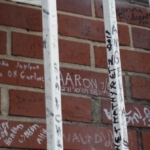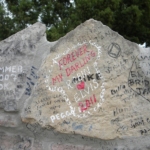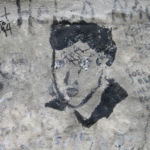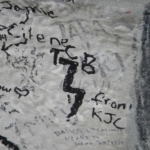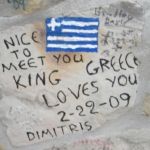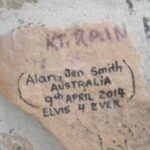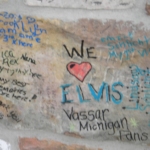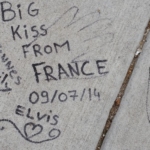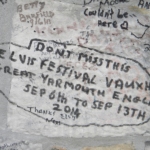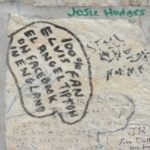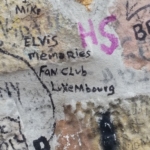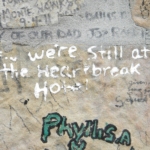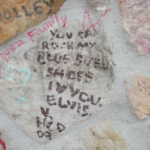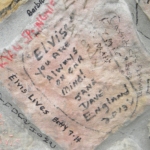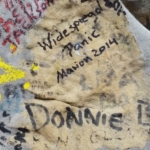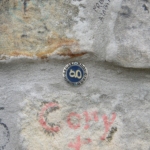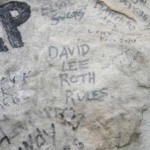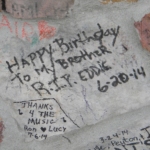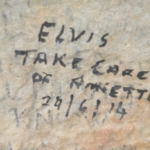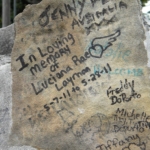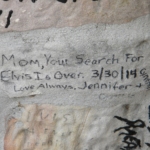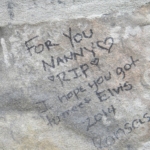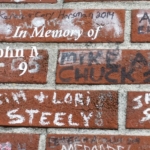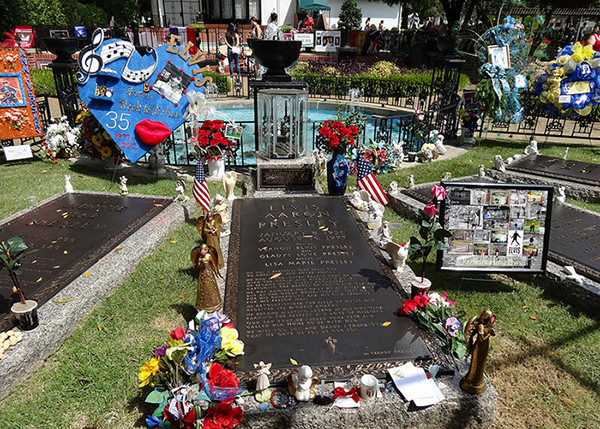
Derek H. Alderman, Hannah Gunderman and Donna G’Segner Alderman
In describing Elvis Presley in Wilson and Ferris’ 1989 Encyclopedia of Southern Culture, Stephen Tucker wrote: “Presley is probably the most famous Southerner of the 20th century.” Elvis occupies third place on John Sheldon Reed’s list of the twenty most influential Southerners of the past century, eclipsed by only Martin Luther King, Jr. and William Faulkner. While public fascination with Elvis’ life and music represents a “southern faith,” in the words of Charles Reagan Wilson, the King of Rock n’ Roll wields an amazing sphere of influence not just within his native American South, but across the nation and the globe.[1] To be convinced of this fact, one only needs to visit the Elvis American Diner, a truck stop and shrine to Elvis on the Jerusalem-Tel Aviv Highway, which hosts prominent businessmen and impersonators alike. The international dimensions of fandom are also present in the rural town of Parkes, New South Wales, which hosts an annual Elvis revival festival to celebrate his birthday.[2] As these situations in Israel and Australia illustrate, the fact that Elvis never visited or toured a location does not dissuade fans from organizing celebrations, memorials, and tourist destinations in his honor.
The intense devotion of Elvis fans has long been a subject of discussion among the mass media and the academic community, but these treatments have tended to draw on a “parody of fandom that makes fans’ interests seem bizarre, trivial, overblown, silly, misguided, and sad.”[3] Yet, scholarship over the past several years provides us a different and more useful understanding of Elvis fans as social actors and memory agents. Erika Doss, in her important book, Elvis Culture: Fans, Faith & Image, argues that fans play a central role in “preserving and controlling Elvis’s history” and “revising and redeeming his historical memory.”[4] Doss attributes the continuing popularity of Elvis in contemporary culture to the versatility of his image and how fans constantly reconstruct Elvis’ image as they engage in their own everyday struggles for public legitimacy and meaning. Fan clubs, which number no less than 500 worldwide, represent particularly important mechanisms for defending Elvis’s reputation and validating the social importance of continuing to remember their idol.
We are interested in the role that place play in the commemorative experience and agency of Elvis fans and they how they fashion the form and meaning of Elvis-related landscapes of memory. Elvis fans, like all social actors and groups, actively construct spaces into meaningful places and inscribe their values, views, and memories into those places, both figuratively and literally. In their desire to ground or emplace devotion to Elvis within places, fans identify with, visit, and even protect locations associated with his life. In the 1990s, fans lobbied local and federal officials to stop the demolition of Elvis’ boyhood home in the Lauderdale Courts housing project in Memphis, Tennessee. Memphis-based fans as well as supporters from across the United States and the globe became important activist voices in directing the preservation of the Courts apartment and the wider development of downtown Memphis. In this case and others, Elvis fans demonstrate their capacity to operate as creative memory agents and place-makers rather than simply passive heritage tourists or pilgrims.[5]
One of the most powerful ways that fans attach meaning to and (re)shape Elvis-related locations is to engage in the practice of pilgrimage. No place of pilgrimage is intrinsically memorable, but made significant through the behaviors, attitudes, and actions of visitors as well as those who manage that pilgrimage experience. The best known and most public of Elvis pilgrimage sites is Graceland. The singer’s final residence and resting place has become an emotionally charged point of convergence for a national and international community of avid fans and curious observers. As a pilgrimage landscape, Graceland is more than just a tourist destination but a site for constructing official and vernacular images of Elvis. These images do not simply retell the life of the entertainer but work to interpret and project Elvis’ biography through a range of larger southern and American cultural beliefs and the personal memories of visitors—all of which in turn help sustain his social importance over time. The process of making Graceland into a sacred geography is obviously controlled by the sponsors of the site, Elvis Presley Enterprises. Graceland officials offer tours and merchandise that communicate a seemingly unified and undisputed historical narrative of Elvis to visitors. At the same time, the meaning of landscapes and places of memory are also constructed by and reflective of the diverse views and interests of ordinary people. We would suggest that the very landscape of Graceland, while a highly regulated and commodified environment, provides nonetheless a text for fans and other visitors to write and rewrite the memory of Elvis on their own terms.[6]
The fieldstone wall in front of Graceland is especially demonstrative of the ways in which fans use place-making to author the meaning of Elvis Presley as a cultural icon. After moving into Graceland in 1957, Elvis built the wall to shield himself and his family from the traffic of admirers and observers.[7] Even while the singer was alive, Graceland’s Wall became a popular place for fans to inscribe their names, hometowns, and personal messages to and about Elvis and the meaning of his legacy to them. It is a practice that has continued and, in fact, intensified since his death. The layering of these graffiti-like inscriptions over time, what Owen Dwyer terms “symbolic accretion,” work to reconstruct discursively and materially the appearance and meaning of the Wall.[8] A landscape feature that originally functioned as a barrier between Elvis and fans has been transformed into a place for visitors to regularly congregate and perform, through the writing and reading of messages, a sense of communion and community with their musical idol. Graceland managers do not discourage the production of fan graffiti and, in fact, have facilitated this tourist place ritual. They have built a drive-up lane adjacent to the Wall to make writing and the taking of pictures, which is quite popular, safer and more accessible. Current promotional brochures for Graceland include a photo of a visitor authoring a Wall inscription.
Rather than a static representation of music and memory, the inscribed Wall is always in a state of “becoming” as new communities and generations of fans and other visitors come to Graceland with a diversity of motivations, expectations, and experiences. This diversity of expression does not detract from the continued commemorative importance of Elvis; rather, it is essential for the continued survival and sustainability of his memory. Indeed, it is not uncommon to find evidence of young people recording their names and ages in the Graceland Wall, suggesting that public fascination with Elvis is not necessarily dying out generationally.
The convergence of musical fandom, place (re)making, and graffiti inscription is not restricted to Elvis, but found in association with a wide range other artists and bands, from the Beatles to U2. Surprisingly, the subject, particularly the Graceland Wall, has received limited academic attention. We suggest that Graceland graffiti represents an especially rich opening to understanding the multiple and sometimes competing discourses or ways of thinking and talking about the Rock n’ Roll artist. As Daniel Wright noted several years ago in his published collection of graffiti from Graceland, visitors connect with the memory of Elvis at different levels of intensity and through different perspectives depending on their personal identities and cultural ideologies.[9]
The Wall is a microcosm of the larger process of social memory construction as the past is reshaped to suit present needs and conditions. A politics of memory flows through the inscriptions at Graceland. They mirror but also depart from the controlled commemorative message presented to people in official Graceland tours and exhibits. As some scholars in memory studies suggest, the public is increasingly unsatisfied with simply accepting authorized histories and therefore seek to express and claim memory and public feeling in visibly public contexts.[10] Because so many authors are contributing to these histories, the rewriting of Elvis’ legacy on the Graceland Wall is open to his detractors as well as his fans. Occasionally, one can find an inscription on the Wall that is critical of Elvis, his family, and the fan experience. Even the most cursory reading of the Graceland Wall reveals the wider global geography of Elvis fandom, as visitors are fond of advertising the city, country and fan club from which they hail. At the same time, many graffiti writers offer very personal sentiments about what Elvis meant not only to them but to a deceased family member—in effect remaking the Graceland Wall, like impromptu memorials in general, into an emotional geography.
The photographs presented in this essay are just a few dozen of several hundred pictures taken in late July 2014. It is impossible to fully capture the content, tone, and feelings of the Graceland Wall in just one piece. As many fans do every day, we walked along the Wall, allowing ourselves to be drawn into the themes and images that caught and held our attention. The reader is encouraged to make the journey to Memphis and conduct his or her own reading (and perhaps writing) of Elvis’ legacy.
Graceland managers provide visitors with a regulated landscape even as it provides a place to reflect upon and pay respect to Elvis. The house and grounds, accessible only by shuttles, is cordoned off in many places and visitors wear headsets with audio descriptions of the estate and Elvis’ life there. The content of the pre-recorded tour is meticulously timed to explain the historical significance of rooms and other spaces while also ensuring that tourists move through house in an efficient way and make way for the next round of visitors. On a practical level, this manner of narration and guiding is unavoidable given the large number of patrons that Graceland must serve, especially during Elvis week in August. According to Elvis Presley Enterprises, over 500,000 people visit Graceland each year, making it one of the five most visited home tours in the United States. In a deeper way, these regulated practices also reflect an effort on the part of Graceland to construct an official image or script of Elvis’ legacy and control how the public remembers him. Carefully, a historical and spatial narrative is fashioned that glorifies Elvis’ “American Dream” rise from poverty in his birthplace of Tupelo, Mississippi and early years in Memphis to the unbridled opulence of Graceland, including the famously indulgent Jungle Room. This is not unique to Presley, but found at many historical and commemorative sites devoted to famous people. In contrast to the controlled experience of the guided audio tour, which does not include the Wall in front of Graceland, the graffiti inscription process give visitors a sense of independence in choosing how they want to textually or graphically memorialize Elvis. From this perspective, making the pilgrimage to Graceland is about being an author or creator of the meaning of Elvis’ memory rather than simply an observer or consumer of it.
The Graceland Wall is a living monument to the enduring legacy of Elvis and is a sign of the pilgrimage that people embark on to celebrate his legacy. Originally built as a source of privacy as a consequence of the singer’s stardom and cultural impact, it is dynamically transformed by visitors who layer or accrete inscriptions of praise, song lyrics, popular culture references, and sometimes criticism, on its brick, mortar, signage, and surrounding sidewalks—creating a multi-faceted landscape of memorialization. Many fans come to Graceland with an expectation of writing on the Wall and leaving their mark on the public remembrance of Elvis while also leaving their footprint, figuratively and sometimes even literally. While authoring graffiti inscriptions is an important way of performing and reconstructing the King of Rock n’ Roll’s image, many visitors come to the Wall and connect with their icon by simply reading, photographing, and internalizing the heart-felt inscriptions of others. Taking pictures of the Wall obviously provides souvenirs, but it also represents a place-making practice in its own right. These pictures are shared with others in Memphis and later after going home; they help to further legitimize Graceland as a pilgrimage landscape and the importance of visitors being able to say: “I was there.”
Elvis, Sexual Desire, and Importance of Female Fans
The contemporary United States has a diversity of pilgrimage landscapes, from those devoted to organized religions (e.g., the Mormon pilgrimage to Temple Square in Salt Lake City) to those journeys associated with the civil religion of American nationalism and patriotism (e.g., pilgrimages to Mount Rushmore or Gettysburg National Military Park). A third type of pilgrimage focuses on the cultural religion of figures from popular culture and mass media, within which Graceland would fall.[11] Graffiti on the Graceland Wall frequently likens Elvis to a religious or spiritual figure. Public adulation for Elvis signals the extent to which fandom can rival, if not exist alongside conventional notions of sacredness. Playing upon the common refrain “Jesus Lives,” many inscriptions proclaim that “Elvis Lives” and reference his immortality. This immortality is not simply the lasting popularity of his music, but also the legacy he left as a human being and someone worth remembering. In some cases, Elvis is endowed with spiritual power, such as the inscription (not pictured here) that read: “Elvis put his hand on my mother’s womb and blessed me.” In other instances, inscriptions on the Graceland Wall point to the fact that some fans see a clear difference between Elvis fandom and traditional forms of faith while others use the Wall to poke fun at the idea of equating Presley with Jesus by actually making these comparisons, prompting a more sophisticated understanding of the motivations behind the journey to Graceland.
Joel Williamson, in his long awaited biography of Elvis Presley, places the rise of the singer’s fandom firmly within the context of post-World War II United States and the relationship between race and sexuality in southern history. In particular, Williamson emphasizes the importance that sexual desire—that of Presley’s female fans and that of Presley himself—in creating Elvis mania. Rather than dismissing or marginalizing the shrieking teenage girls at Elvis’ early performances, Williamson calls on us to pay attention to the unique cultural changes and tensions in which these women came of age and understand how Elvis fandom allowed them to break away, at least temporarily, from the confines of southern society and express themselves sexually.[12] Heartfelt expressions of love and romance for Elvis are frequently inscribed on the Graceland Wall. And while these expressions are not limited to women, the large number of graffiti inscriptions authored by females is noteworthy and provide further evidence of the importance of interpreting Elvis fandom in a way that gives legitimacy to gender and sexual identity. Also important is the way in which Graceland Wall is made part of the expression of love beyond just for Elvis. In one photographed marking, “Marilyn” uses the Wall graffiti to recount a romantic history that began with Elvis as her first love, followed then by “Johnny O.”, and culminating with “L.R. Mulvaney” winning her heart.
Reputational Politics of Elvis
When conducting a close reading of the Graceland Wall, one can detect “reputational politics” at work, a realization that Elvis’ reputation or image is not universally fixed but always open to redefinition and even debate.[13] His legacy, according to scholars such as Michael Bertrand, is contested, especially when examined through the lens of race. While Presley can certainly be seen as a challenger and re-negotiator of the lines of racial segregation within American popular music, he has also been interpreted by his critics as someone who continued a long tradition of whites appropriating and profiting from the labors and artistry of African Americans.[14] The public accessibility of the Wall allows both positive and negative reflections on the legacy of Elvis, creating a potentially conflicted landscape of memory. While most of the graffiti praises Elvis, there is an occasional inscription that openly rebukes him and critiques his legacy. There is no guarantee that the “Fuck Elvis” or “Die Elvis” messages were left by a visitor and not by a local Memphian trying to be funny if not fed up with Elvis tourism in the city. According to Cathryn Stout, a former reporter and columnist for Memphis’ Commercial Appeal newspaper, these local critics might include the long embattled residents of the predominantly black Whitehaven neighborhoods that surround Graceland. The economic success of Graceland has not traditionally benefitted the Whitehaven community as it endures noise, traffic, and expansion pressures from the tourist site.[15] The fact that such negative inscriptions go unnoticed by management is suggestive of the extent to which the Graceland Wall is a less controlled environment than what one finds at the Graceland mansion and gift shops. Indeed, in contrast to the official tour narrative’s silence about Elvis’ prescription drug abuse and overdose, inscriptions on the Wall do not always sanitize his life. Negative inscriptions do not lessen the importance of the Wall as a symbol of the singer’s impact on popular culture; rather, they reiterate the fact that his reputation gains not just devout followers but also dissenters. The Wall is reflective of these diverse and sometimes divided opinions.
Graceland Wall: The Fight for Visibility
Inscriptions have come to cover almost every nook and cranny of the Wall, creating a visual and symbolic palimpsest in which traces of past and present writings are present together even as they blur the legibility of each other. Because of the large volume of messages left at the Graceland Wall by visitors, inscriptions often compete for visibility. Moreover, the lasting power of this graffiti is compromised by the natural elements and those times in which Graceland managers clean the Wall to accommodate more writings. Visibility is important to some inscribing visitors as they celebrate not only the singer but also their unique fandom. Visitors to the Wall author memorials to their beloved singer on all suitable canvases on and near the Wall, including signage and security railings meant to provide a sense of authority to the Graceland landscape. Graffiti inscriptions have begun to scatter across a wooden bridge connecting Graceland to its parking lot, demonstrating a spillover onto new, untransformed surfaces as a canvas for memorialization. Arguably, in an effort to rise above the sea of textual inscriptions as well as to conduct their own personal memory- and place-making, some visitors to the Wall render unique portraits of Elvis and Elvis’ TCB (“Taking Care of Business”) lightning bolt logo. Also in an effort to create a more prominent expression of the bond between an individual fan and the memory of Elvis, some visitors write or draw on the Wall at a scale or size much larger than other inscriptions, in media even beyond simple pen and ink (such as paint and nail polish), or even go as far as carving their mark into stone. In doing so, they can effectively “extend” Elvis’s legacy as well as their own by increasing the permanence of their inscriptions.
Graceland Wall as Global Gathering Place
The cultural power of Graceland as an Elvis-related landscape of memory is not simply that it was once the house and now the gravesite of Presley and his family. Rather, Graceland also serves as a gathering place for many fans associated with clubs, an identification often inscribed into the Wall. In the words of Elvis scholar Gilbert Rodman, Graceland is “a physical point of articulation, where a global community of Elvis’s fans regularly congregate and acquire a true sense of themselves as self-defined community.”[16] Graffiti writers use the Wall to document their country of origin and the past dates in which they previously visited Graceland, thus providing insight into the level of commitment of Elvis’ fans. The memorialization of musical phenomena is shaped and changed by the current social and cultural environment in which it exists, and the increasing popularity of social media has influenced how fans of Elvis have chosen to personalize their messages on the Wall. References to social media outlets prompt us to consider how Graceland graffiti might help facilitate communication between fans and bridge digital and material memory-making. The collective aspect of social media networks and their incorporation into inscriptions demonstrates Rodman’s sense of community and how individual expression and diverse discourse occur in an atmosphere of fan camaraderie and solidarity.
Graceland Visitors Can Follow the Beat of their Own Drum
Research on pilgrimage has traditionally emphasized the group dynamics, specifically the social equality or communitas, which can develop when people travel to sacred sites. Freed from the norms and structures of everyday society, pilgrims are more open to new experiences and try on new identities. Newer approaches recognize the heterogeneity of the pilgrimage experience and that pilgrimage sites or landscapes are arenas for competing discourses from which visitors recover and reconstruct meaning.[17] While inscriptions on the Graceland Wall capture the social togetherness and common belonging felt by many Elvis fans, these memorial markings also speak to the fact that fans do not connect with Elvis and travel to Memphis for a single grand narrative or meaning. They bring their already established identities, memories, and motivations to the Wall and these are written into the inscriptions left behind. Manipulating song lyrics of Elvis to honor the music he created is a common form of memorialization on the Graceland Wall and demonstrates a personalization of his legacy by visitors. Choice of a particular song lyric or song reference is of strong importance to the visitor, and thus transcends being a simple reference to his music but rather is a symbol of how the music of Elvis affected the fan’s personal life. Not all musical references on the Wall are confined to Elvis. References to musical artists other than Elvis are found on the Graceland Wall, and, on occasion, the inscriptions compare these other musical icons to Elvis. While remembering other musical legacies on the Wall seemingly disrupts the cult of Elvis’s following and the homogeneity of memorialization at Graceland, it is perhaps also represents an attempt to elevate the reputation of the artist to the established cultural status of Elvis by memorializing them on and through the same cultural landscape.
Remembering Others by Memorializing Elvis
As cultural geographer Rob Kruse suggests in studying Beatle fandom, fans establish their own “emotional geographies” around musical celebrities. In doing so, they transform seemingly ordinary spaces into highly charged places of memory and identity.[18] In transforming the Graceland Wall into an emotional geography, visitor inscriptions frequently honor their own family members who have passed away, creating an individualized and intimate memorialization of not just Elvis also the lost loved one. In some cases, as indicated through messages on the Wall, fans undertake the journey to Graceland on behalf their departed family member, who loved Elvis but was never able to make the trip. In these and other cases, visitors have chosen to memorialize Elvis through the prism of their own familial experiences, reaffirming the enduring relevance of the singer’s music and legacy to the private lives of thousands of individuals who have chosen to make the pilgrimage to Graceland. For these fans, Elvis was more than a popular singer epitomizing the American and southern experience. Rather, it is as if he were a member of their families, which is perhaps a more helpful interpretive frame for understanding the Elvis fan phenomenon beyond simply characterizing it as a false or bizarre religious or spiritual experience. It is important to take Elvis fans seriously as authors of Elvis’ memory and the makers of places that honor him.[19]
Derek H. Alderman is Professor of Geography and Department Head at the University of Tennessee and a cultural and historical geographer interested in public memory, popular culture, and heritage tourism in the U.S. South. He is founder and co-coordinate the RESET (Race, Ethnicity, and Social Equity in Tourism) Initiative, and is part of a team of five universities on a large NSF-funded project on race, slavery and plantation tourism. He can be followed @MLKStreet.
Hannah Gunderman is a PhD Student in the Department of Geography at the University of Tennessee. Her dissertation will examine the cultural impacts of invasive lake trout in Yellowstone National Park.
Donna G’Segner Alderman is a lecturer in the Department of Theory and Practice in Education at University of Tennessee. She has previously published on cultural phenomena in the U.S. South.
[1] Stephen R. Tucker, “Elvis,” in Encyclopedia of Southern Culture, eds. Charles R. Wilson and William Ferris (Chapel Hill: University of North Carolina Press, 1989), 1077-1078; John Shelton Reed, “The Twenty Most Influential Southerners of the Twentieth Century,” Southern Cultures 7, no. 1 (2001): 96-100; Charles Reagan Wilson, Judgment & Grace in Dixie: Southern Faiths from Faulkner to Elvis (Athens: University of Georgia Press, 1995).
[2] Gretchen Wood, “Outback Elvis: Riding with the King in Parkes, Australia,” Southern Cultures 19, no. 1 (2013): 98-110; John Connell and Chris Gibson, “The Parkes Elvis Revival Festival: Economic development and Contested Place Identities in Rural Australia,” Geographical Research 45, no. 1 (2007): 71-84.
[3] Mark Duffett, “False Faith or False Comparison? A critique of the Religious Interpretation of Elvis Fan culture,” Popular Music and Society 26, no. 4 (2003): 513-522, 516.
[4] Erika Lee Doss, Elvis Culture: Fans, Faith, & Image (Lawrence: University Press of Kansas, 1999), 58.
[5] Derek H. Alderman, “The Politics of Saving the King’s Court: Why We Should Take Elvis Fans Seriously,” Southern Quarterly 46, no. 1 (2008): 46-77.
[6] Derek H. Alderman, “Writing on the Graceland wall: On the Importance of Authorship in Pilgrimage Landscapes,” Tourism Recreation Research 27, no. 2 (2002): 27-33.
[7] Daniel Wright, Dear Elvis: Graffiti from Graceland (Memphis: Mustang Publishing, 1996).
[8] Owen J. Dwyer, “Symbolic Accretion and Commemoration,” Social & Cultural Geography 5, no. 3 (2004): 419-435.
[9] Wright, Dear Elvis: Graffiti from Graceland.
[10] Erika Doss, Memorial Mania: Public Feeling in America (University of Chicago Press, 2012); Derek H. Alderman and Joshua FJ Inwood, “Landscapes of Memory and Socially Just Futures,” in The Wiley-Blackwell Companion to Cultural Geography, eds. Nuala Johnson, Richard Schein, and Jamie Winders (Malden, MA: John Wiley & Sons, 2013), 186-197.
[11] Juan Eduardo Campo, “American Pilgrimage Landscapes,” The Annals of the American Academy of Political and Social Science 558, no. 1 (1998): 40-56.
[12] Joel Williamson, Elvis Presley: A Southern Life (New York: Oxford University Press, 2015).
[13] Alderman, “The Politics of Saving the King’s Court.”
[14] Michael T. Bertrand, “Elvis Presley and the Politics of Popular Memory,” Southern Cultures 13, no. 3 (2007): 62-86.
[15] Cathryn Stout, A Place of Happy Retreat: Benefiting Locals and Visitors Through Sustainable Tourism Practices at Beale Street, Graceland and the National Civil Rights Museum (MA Thesis, University of Mississippi, 2011); Cathryn Stout, “Viewpoint: Graceland and its Whitehaven neighbors may be finding common ground,” The Commercial Appeal, 15 August 2010, Available online at http://www.commercialappeal.com/opinion/opening-the-gates-of-graceland-all-in-this
[16] Gilbert B. Rodman, Elvis after Elvis: The Posthumous Career of a Living Legend (New York: Routledge, 1996), 103.
[17] N. Collins-Kreiner, “Researching Pilgrimage: Continuity and Transformations,” Annals of Tourism Research 37, no. 2 (2010): 440–456; Thomas W. Crawford, “Finding the Real America on the TransAmerica Bicycle Trail: Landscapes and Meanings of a Contemporary Secular Pilgrimage,” in The Changing World Religion Map, ed. Stan Brunn (Netherlands: Springer, 2015), 855-873.
[18] Robert J. Kruse II, A Cultural Geography of the Beatles (Lewiston, NY: Edwin Mellen Press, 2005).
[19] Alderman, “The Politics of Saving the King’s Court.”

